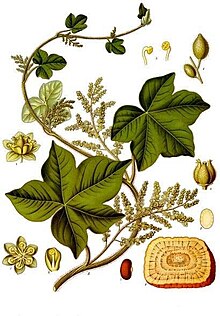Jateorhiza palmata
This article needs additional citations for verification. (February 2015) |
| Jateorhiza palmata | |
|---|---|

| |
| Scientific classification | |
| Kingdom: | Plantae |
| Clade: | Tracheophytes |
| Clade: | Angiosperms |
| Clade: | Eudicots |
| Order: | Ranunculales |
| Family: | Menispermaceae |
| Genus: | Jateorhiza |
| Species: | J. palmata
|
| Binomial name | |
| Jateorhiza palmata | |
| Synonyms[1] | |
Jateorhiza palmata (calumba) is a perennial climbing plant from East Africa. It contains isoquinoline alkaloids and is used mainly as a bitter tonic especially in cases of anorexia nervosa. It contains no tannins, hence it can be safely used in iron preparations for the treatment of anaemia without the fear of precipitation resulted from in vitro interaction.
Description[]
Tall, dioecious twining perennial vine; often reaching the tops of trees. The annual stems, one or two from each root, are hair with glandular tips and have large bright green membranous leaves which are palmate, alternate and long petioled. The flowers are insignificant and greenish white. The female flower is followed by moon-shaped stone in a drupe. Male flowers are in 30 centimetres (12 in) long panicles. The tuberous root is large and fleshy, about 3–8 centimetres (1.2–3.1 in) in diameter with a thick bark. Transverse section yellowish, outside greyish brown. Taste is muscilagenous and very bitter.
References[]
- ^ a b "Jateorhiza palmata". Germplasm Resources Information Network (GRIN). Agricultural Research Service (ARS), United States Department of Agriculture (USDA). Retrieved 22 February 2015.
External links[]
- Dressler, S.; Schmidt, M. & Zizka, G. (2014). "Jateorhiza palmata". African plants – a Photo Guide. Frankfurt/Main: Forschungsinstitut Senckenberg.
- Menispermaceae
- Flora of Africa
- Plants described in 1797
- Ranunculales stubs